Pecharsky V.K., Zavalij P.Y. Fundamentals of Powder Diffraction and Structural Characterization of Materials
Подождите немного. Документ загружается.

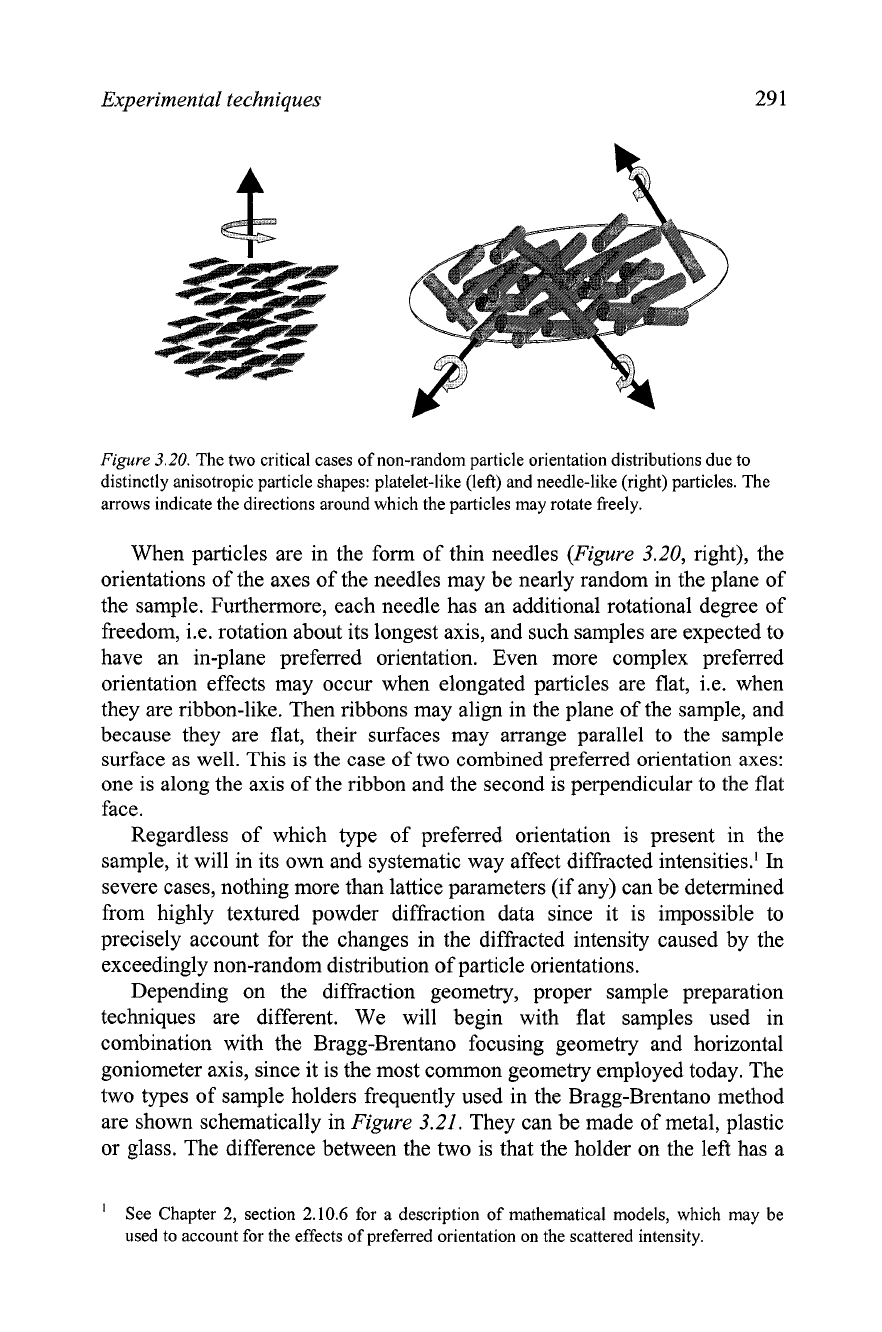
Experimental techniques
Figure
3.20.
The two critical cases of non-random particle orientation distributions due to
distinctly anisotropic particle shapes: platelet-like (left) and needle-like (right) particles. The
arrows indicate the directions around which the particles may rotate freely.
When particles are in the form of thin needles
(Figure
3.20, right), the
orientations of the axes of the needles may be nearly random in the plane of
the sample. Furthermore, each needle has an additional rotational degree of
freedom, i.e. rotation about its longest axis, and such samples are expected to
have an in-plane preferred orientation. Even more complex preferred
orientation effects may occur when elongated particles are flat, i.e. when
they are ribbon-like. Then ribbons may align in the plane of the sample, and
because they are flat, their surfaces may arrange parallel to the sample
surface as well. This is the case of two combined preferred orientation axes:
one is along the axis of the ribbon and the second is perpendicular to the flat
face.
Regardless of which type of preferred orientation is present in the
sample, it will in its own and systematic way affect diffracted intensities.'
In
severe cases, nothing more than lattice parameters (if any) can be determined
from highly textured powder diffraction data since it is impossible to
precisely account for the changes in the diffracted intensity caused by the
exceedingly non-random distribution of particle orientations.
Depending on the diffraction geometry, proper sample preparation
techniques are different. We will begin with flat samples used in
combination with the Bragg-Brentano focusing geometry and horizontal
goniometer axis, since it is the most common geometry employed today. The
two types of sample holders frequently used in the Bragg-Brentano method
are shown schematically in
Figure
3.21. They can be made of metal, plastic
or glass. The difference between the two is that the holder on the left has a
'
See Chapter 2, section 2.10.6 for a description of mathematical models, which may be
used to account for the effects of preferred orientation on the scattered intensity.
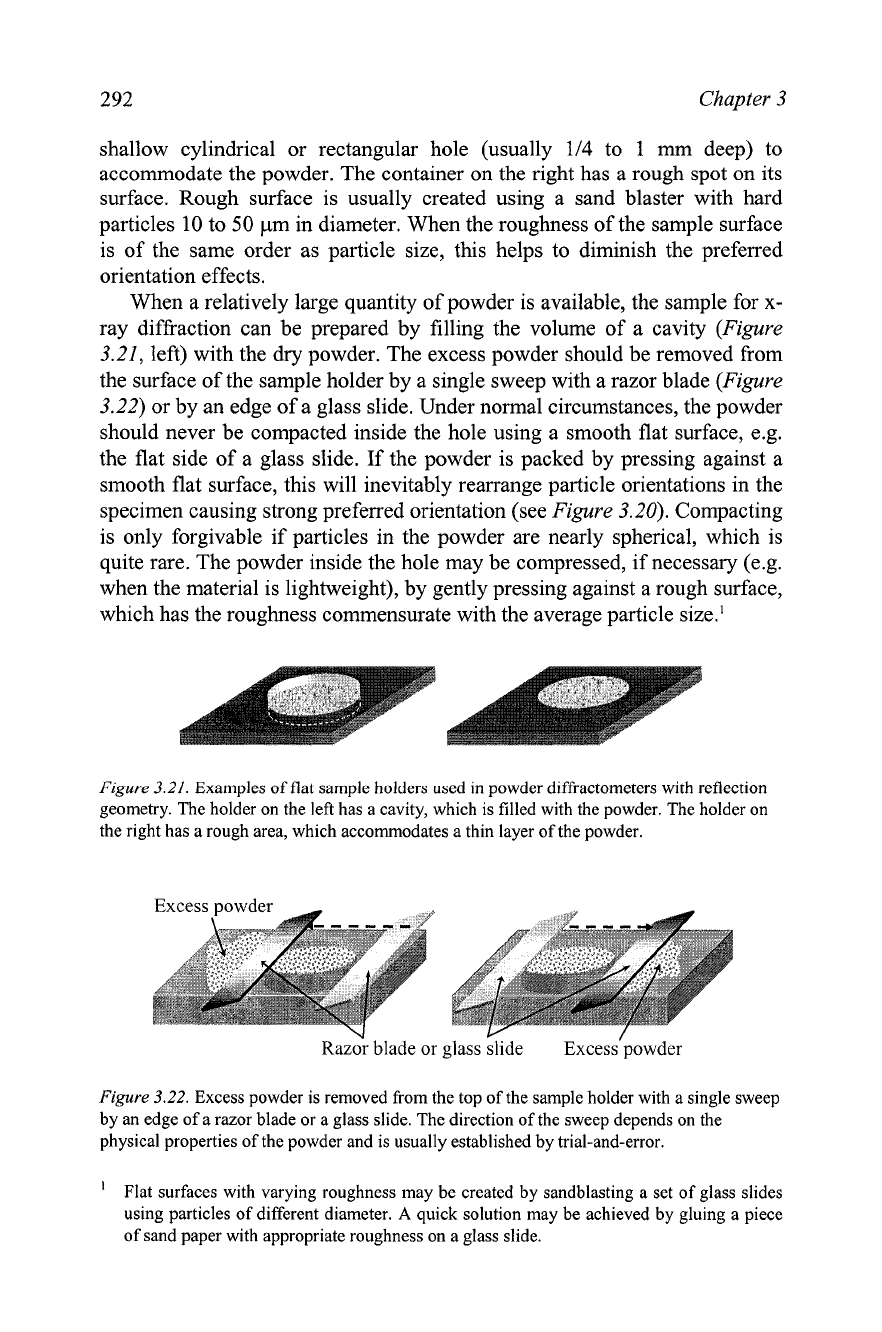
292
Chapter 3
shallow cylindrical or rectangular hole (usually
114
to
1
mm deep) to
accommodate the powder. The container on the right has a rough spot on its
surface. Rough surface is usually created using a sand blaster with hard
particles
10
to
50
pm in diameter. When the roughness of the sample surface
is of the same order as particle size, this helps to diminish the preferred
orientation effects.
When a relatively large quantity of powder is available, the sample for
x-
ray diffraction can be prepared by filling the volume of a cavity (Figure
3.21, left) with the dry powder. The excess powder should be removed from
the surface of the sample holder by a single sweep with a razor blade (Figure
3.22) or by an edge of a glass slide. Under normal circumstances, the powder
should never be compacted inside the hole using a smooth flat surface, e.g.
the flat side of a glass slide. If the powder is packed by pressing against a
smooth flat surface, this will inevitably rearrange particle orientations in the
specimen causing strong preferred orientation (see Figure 3.20). Compacting
is only forgivable if particles in the powder are nearly spherical, which is
quite rare. The powder inside the hole may be compressed, if necessary (e.g.
when the material is lightweight), by gently pressing against a rough surface,
which has the roughness commensurate with the average particle size.'
figure
3.21.
Exanlples of flat sample holders used in powder d~ffractometers with reflection
geometry. The holder on the left has a cavity, which is filled with the powder. The holder on
the right has a rough area, which accommodates a thin layer of the powder.
Figure
3.22.
Excess powder is removed from the top of the sample holder with a single sweep
by an edge of a razor blade or a glass slide. The direction of the sweep depends on the
physical properties of the powder and is usually established by trial-and-error.
'
Flat surfaces with varying roughness may be created by sandblasting a set of glass slides
using particles of different diameter.
A
quick solution may be achieved by gluing a piece
of sand paper with appropriate roughness on a glass slide.
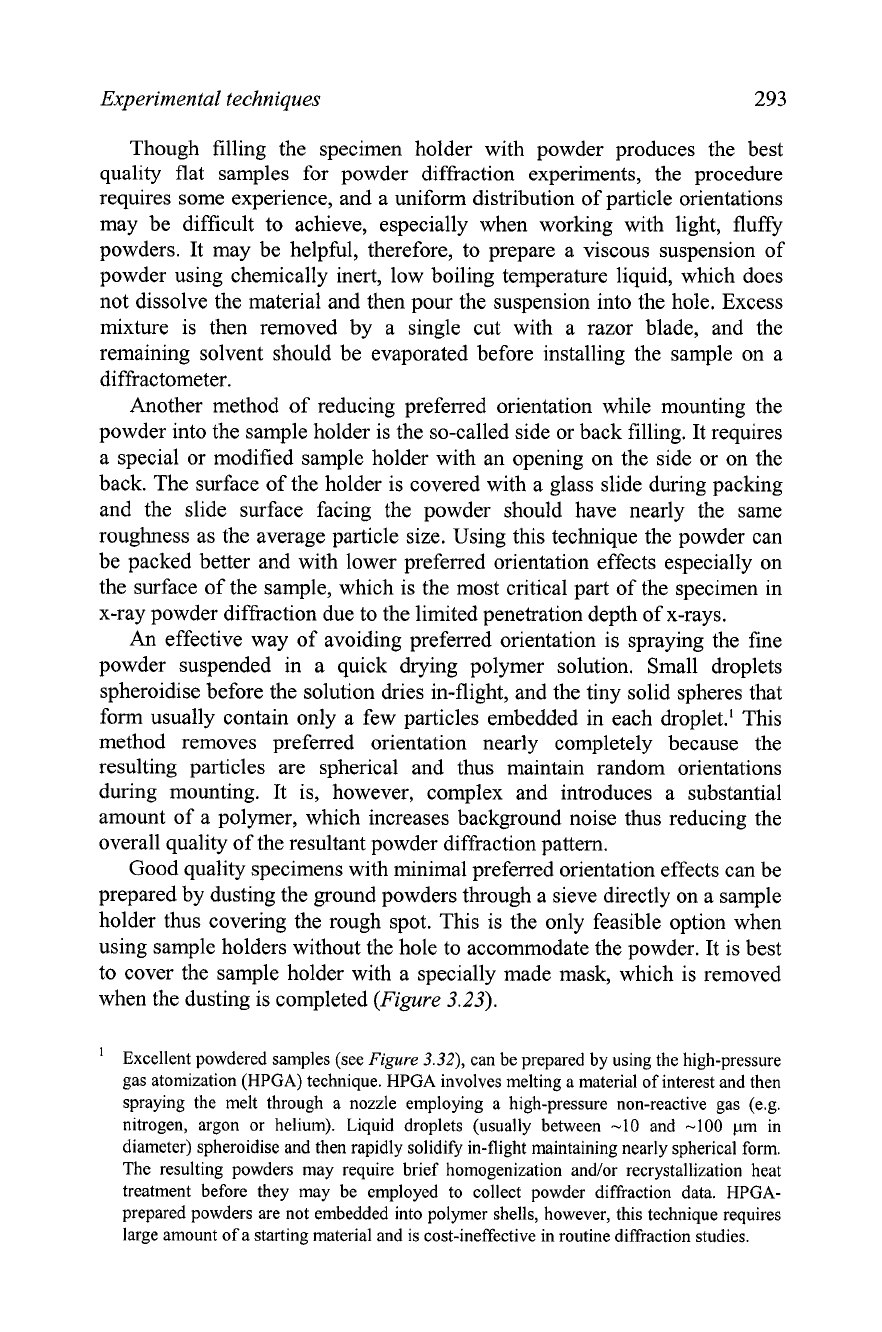
Experimental techniques
293
Though filling the specimen holder with powder produces the best
quality flat samples for powder diffraction experiments, the procedure
requires some experience, and a uniform distribution of particle orientations
may be difficult to achieve, especially when working with light, fluffy
powders. It may be helpful, therefore, to prepare a viscous suspension of
powder using chemically inert, low boiling temperature liquid, which does
not dissolve the material and then pour the suspension into the hole. Excess
mixture is then removed by a single cut with a razor blade, and the
remaining solvent should be evaporated before installing the sample on a
di ffractometer.
Another method of reducing preferred orientation while mounting the
powder into the sample holder is the so-called side or back filling. It requires
a special or modified sample holder with an opening on the side or on the
back. The surface of the holder is covered with a glass slide during packing
and the slide surface facing the powder should have nearly the same
roughness as the average particle size. Using this technique the powder can
be packed better and with lower preferred orientation effects especially on
the surface of the sample, which is the most critical part of the specimen in
x-ray powder diffraction due to the limited penetration depth of x-rays.
An effective way of avoiding preferred orientation is spraying the fine
powder suspended in a quick drying polymer solution. Small droplets
spheroidise before the solution dries in-flight, and the tiny solid spheres that
form usually contain only a few particles embedded in each droplet.' This
method removes preferred orientation nearly completely because the
resulting particles are spherical and thus maintain random orientations
during mounting. It is, however, complex and introduces a substantial
amount of a polymer, which increases background noise thus reducing the
overall quality of the resultant powder diffraction pattern.
Good quality specimens with minimal preferred orientation effects can be
prepared by dusting the ground powders through a sieve directly on a sample
holder thus covering the rough spot. This is the only feasible option when
using sample holders without the hole to accommodate the powder. It is best
to cover the sample holder with a specially made mask, which is removed
when the dusting is completed
(Figure
3.23).
'
Excellent powdered samples (see
Figure
3.32),
can be prepared by using the high-pressure
gas atomization (HPGA) technique. HPGA involves melting a material of interest and then
spraying the melt through a nozzle employing a high-pressure non-reactive gas (e.g.
nitrogen, argon or helium). Liquid droplets (usually between -10 and -100 pm in
diameter) spheroidise and then rapidly solidify in-flight maintaining nearly spherical form.
The resulting powders may require brief homogenization
andlor recrystallization heat
treatment before they may be employed to collect powder diffraction data. HPGA-
prepared powders are not embedded into polymer shells, however, this technique requires
large amount of a starting material and is cost-ineffective in routine diffraction studies.
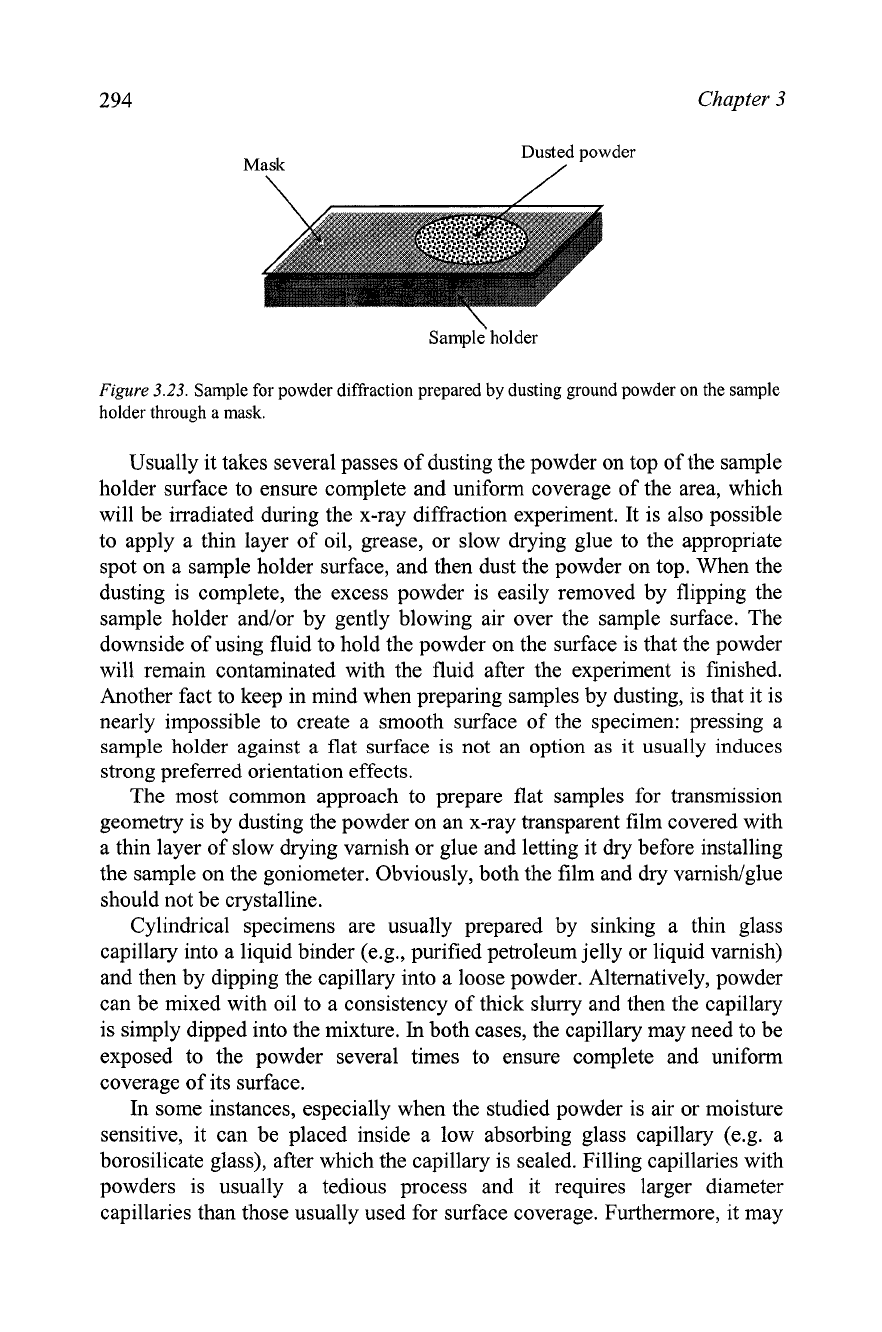
Dusted powder
Mask
Chapter
3
Figure
3.23.
Sample for powder diffraction prepared
by
dusting ground powder on the sample
holder through
a
mask.
Usually it takes several passes of dusting the powder on top of the sample
holder surface to ensure complete and uniform coverage of the area, which
will be irradiated during the x-ray diffraction experiment. It is also possible
to apply a thin layer of oil, grease, or slow drying glue to the appropriate
spot on a sample holder surface, and then dust the powder on top. When the
dusting is complete, the excess powder is easily removed by flipping the
sample holder
andlor by gently blowing air over the sample surface. The
downside of using fluid to hold the powder on the surface is that the powder
will remain contaminated with the fluid after the experiment is finished.
Another fact to keep in mind when preparing samples by dusting, is that it is
nearly impossible to create a smooth surface of the specimen: pressing a
sample holder against a flat surface is not an option as it usually induces
strong preferred orientation effects.
The most common approach to prepare flat samples for transmission
geometry is by dusting the powder on an x-ray transparent film covered with
a thin layer of slow drying varnish or glue and letting it dry before installing
the sample on the goniometer. Obviously, both the film and dry
varnishlglue
should not be crystalline.
Cylindrical specimens are usually prepared by sinking a thin glass
capillary into a liquid binder (e.g., purified petroleum jelly or liquid varnish)
and then by dipping the capillary into a loose powder. Alternatively, powder
can be mixed with oil to a consistency of thick slurry and then the capillary
is simply dipped into the mixture.
In
both cases, the capillary may need to be
exposed to the powder several times to ensure complete and uniform
coverage of its surface.
In
some instances, especially when the studied powder is air or moisture
sensitive, it can be placed inside a low absorbing glass capillary (e.g. a
borosilicate glass), after which the capillary is sealed. Filling capillaries with
powders is usually a tedious process and it requires larger diameter
capillaries than those usually used for surface coverage. Furthermore, it may
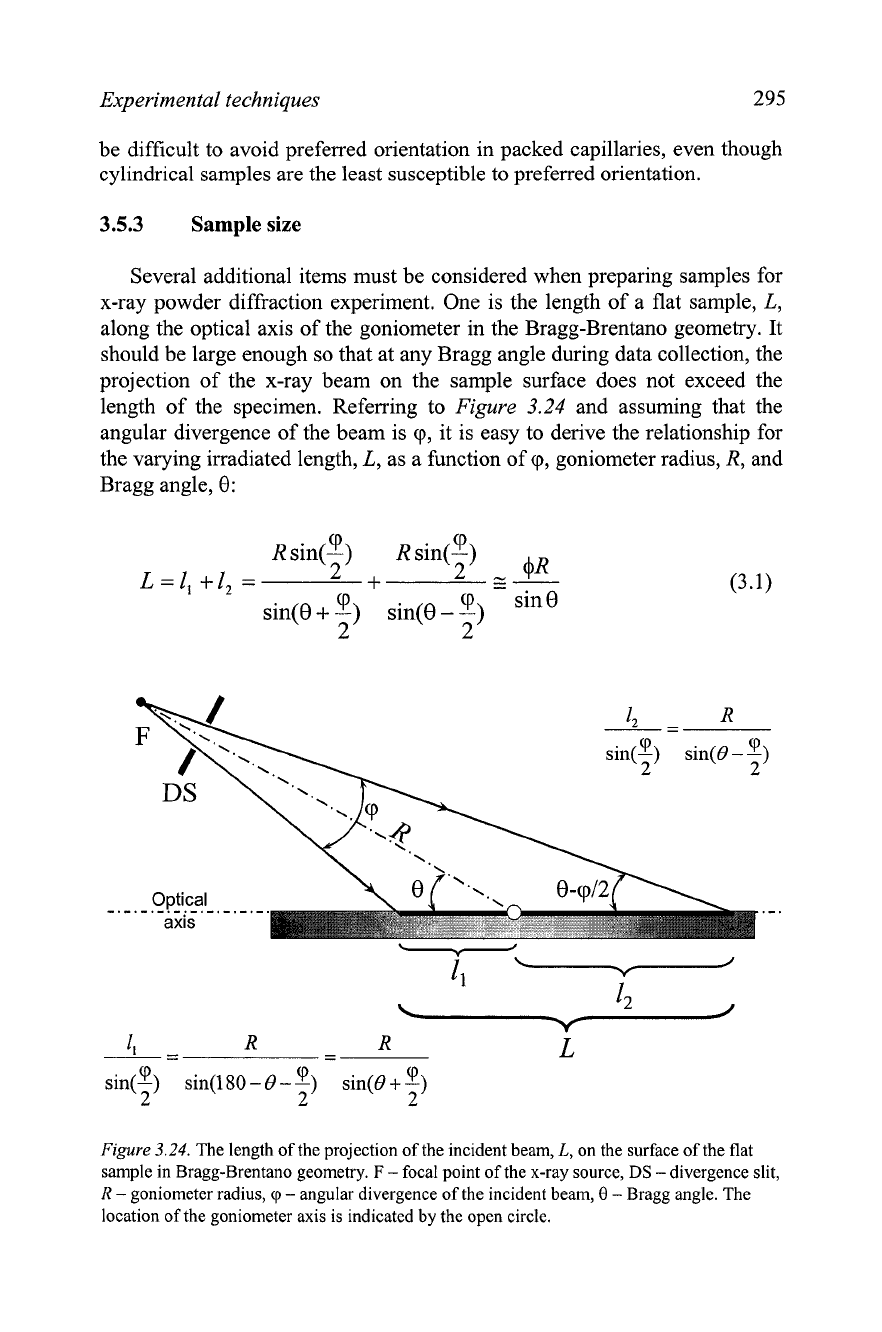
Experimental techniques
295
be difficult to avoid preferred orientation in packed capillaries, even though
cylindrical samples are the least susceptible to preferred orientation.
3.5.3
Sample
size
Several additional items must be considered when preparing samples for
x-ray powder diffraction experiment. One is the length of a flat sample,
L,
along the optical axis of the goniometer in the Bragg-Brentano geometry. It
should be large enough so that at any Bragg angle during data collection, the
projection of the x-ray beam on the sample surface does not exceed the
length of the specimen. Referring to
Figure
3.24
and assuming that the
angular divergence of the beam is cp, it is easy to derive the relationship for
the varying irradiated length,
L,
as a function of cp, goniometer radius,
R,
and
Bragg angle,
9:
Figure
3.24.
The length of the projection of the incident beam,
L,
on the surface of the flat
sample in Bragg-Brentano geometry.
F
-
focal point of the x-ray source,
DS
-divergence slit,
R
-
goniometer radius,
cp
-
angular divergence of the incident beam,
0
-
Bragg angle. The
location of the goniometer axis is indicated by the open circle.
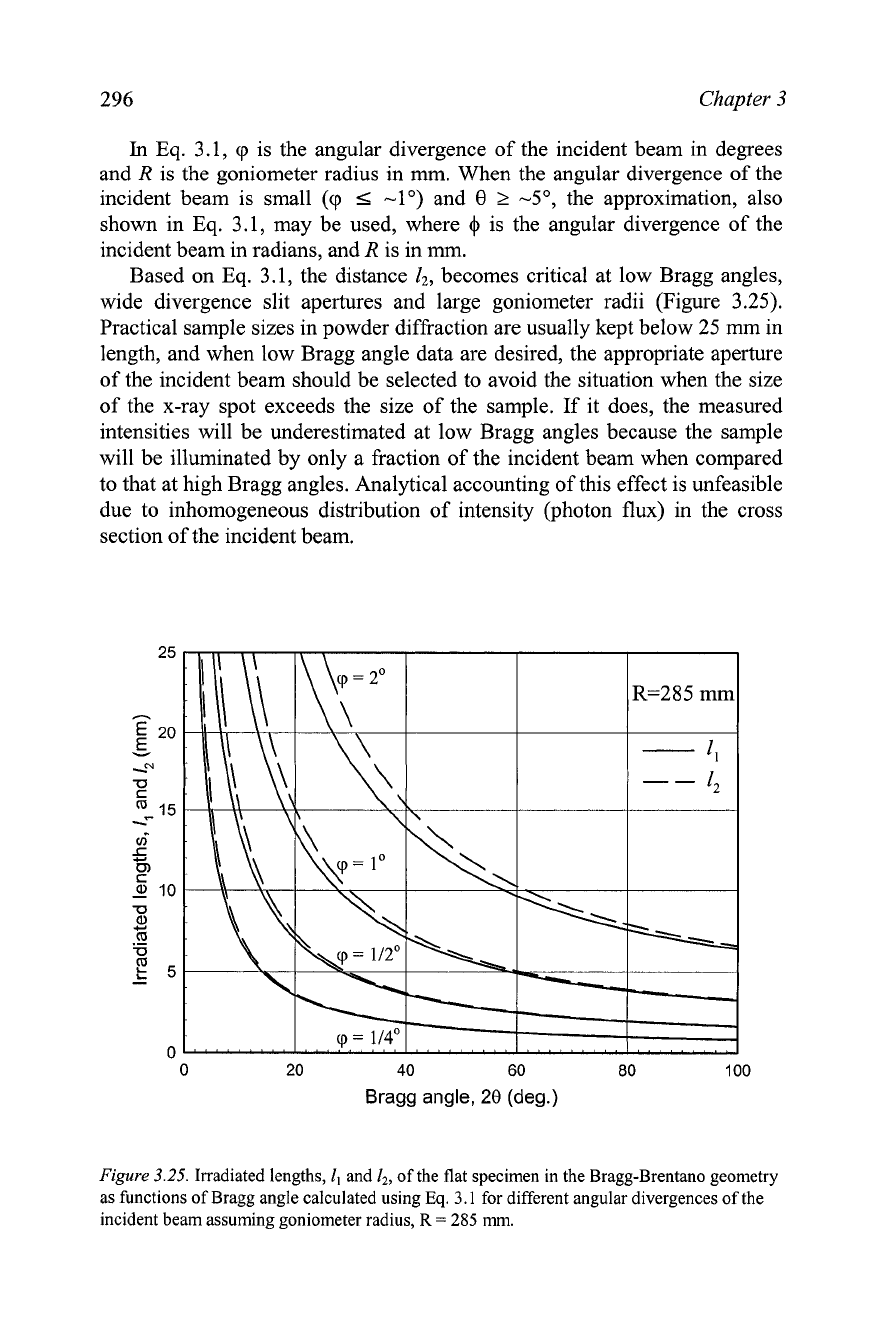
296
Chapter
3
In
Eq.
3.1,
cp
is the angular divergence of the incident beam in degrees
and
R
is the goniometer radius in mm. When the angular divergence of the
incident beam is small
(9
5
-lo) and
8
2
-5O, the approximation, also
shown in
Eq.
3.1, may be used, where
4
is the angular divergence of the
incident beam in radians, and
R
is in
rnm.
Based on
Eq.
3.1, the distance
12,
becomes critical at low Bragg angles,
wide divergence slit apertures and large goniometer radii (Figure
3.25).
Practical sample sizes in powder
diffraction
are usually kept below 25 mm in
length, and when low Bragg angle data are desired, the appropriate aperture
of the incident beam should be selected to avoid the situation when the size
of the x-ray spot exceeds the size of the sample. If it does, the measured
intensities will be underestimated at low Bragg angles because the sample
will be illuminated by only a fraction of the incident beam when compared
to that at high Bragg angles. Analytical accounting of this effect is unfeasible
due to inhomogeneous distribution of intensity (photon flux) in the cross
section of the incident beam.
0
20
40
60
80
100
Bragg angle,
28
(deg.)
Figure
3.25.
Irradiated lengths,
1,
and
12,
of the flat specimen in the Bragg-Brentano geometry
as functions of Bragg angle calculated using
Eq.
3.1
for different angular divergences of the
incident beam assuming goniometer radius,
R
=
285
mm.
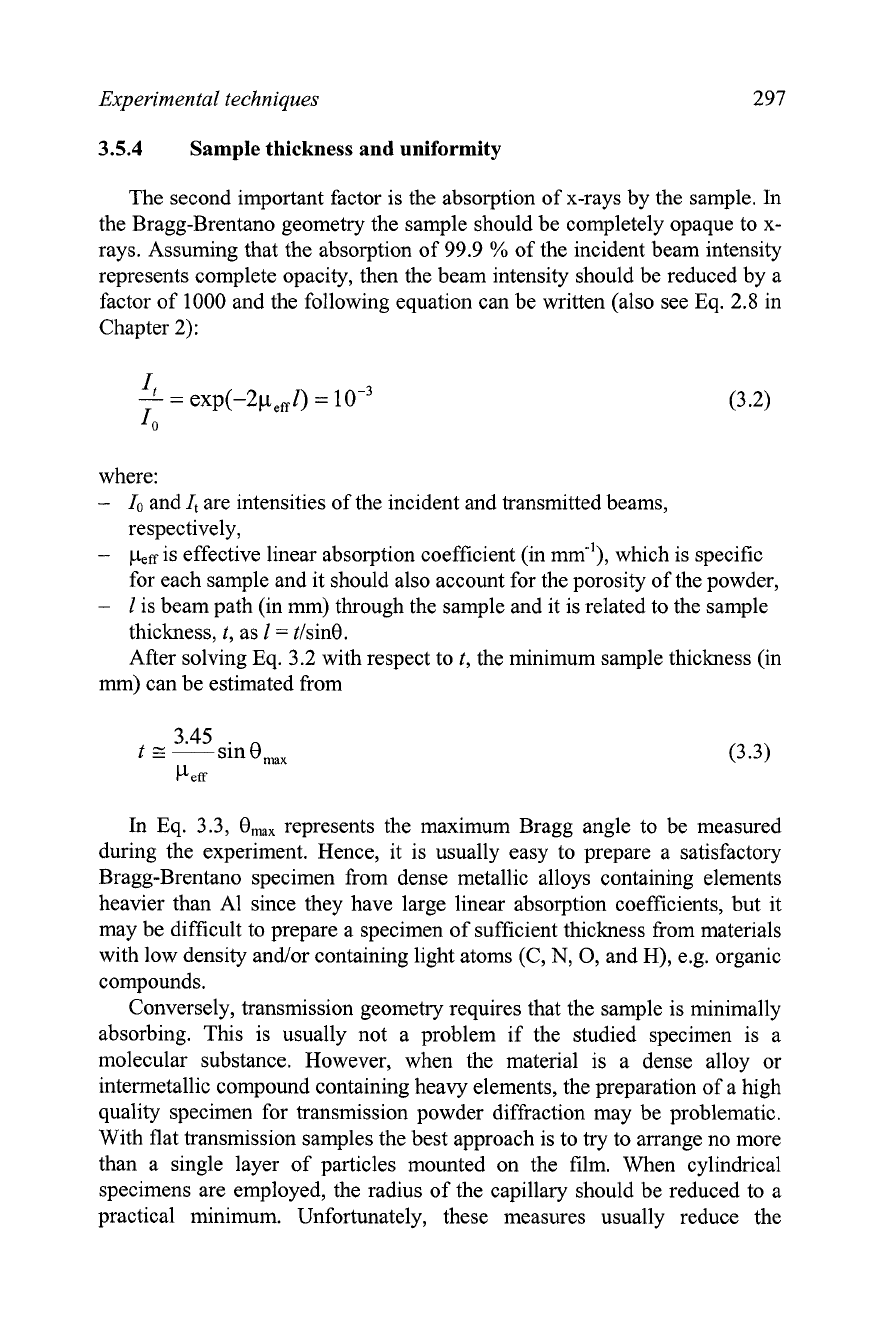
Experimental techniques
297
3.5.4
Sample thickness and uniformity
The second important factor is the absorption of x-rays by the sample. In
the Bragg-Brentano geometry the sample should be completely opaque to x-
rays. Assuming that the absorption of 99.9
%
of the incident beam intensity
represents complete opacity, then the beam intensity should be reduced by a
factor of
1000
and the following equation can be written (also see Eq. 2.8 in
Chapter 2):
where:
-
I0
and
I,
are intensities of the incident and transmitted beams,
respectively,
-
peff
is effective linear absorption coefficient (in mm-'), which is specific
for each sample and it should also account for the porosity of the powder,
-
1
is beam path (in mm) through the sample and it is related to the sample
thickness, t, as
1
=
thine.
After solving Eq.
3.2
with respect to t, the minimum sample thickness (in
mm) can be estimated from
3.45
t
z
-
sin
€I,,,
P
eff
In
Eq. 3.3,
Om,
represents the maximum Bragg angle to be measured
during the experiment. Hence, it is usually easy to prepare a satisfactory
Bragg-Brentano specimen from dense metallic alloys containing elements
heavier than A1 since they have large linear absorption coefficients, but it
may be difficult to prepare a specimen of sufficient thickness Erom materials
with low density andlor containing light atoms
(C,
N,
0,
and H), e.g. organic
compounds.
Conversely, transmission geometry requires that the sample is minimally
absorbing. This is usually not a problem if the studied specimen is a
molecular substance. However, when the material is a dense alloy or
intermetallic compound containing heavy elements, the preparation of a high
quality specimen for transmission powder diffraction may be problematic.
With flat transmission samples the best approach is to try to arrange no more
than a single layer of particles mounted on the film. When cylindrical
specimens are employed, the radius of the capillary should be reduced to a
practical minimum. Unfortunately, these measures usually reduce the
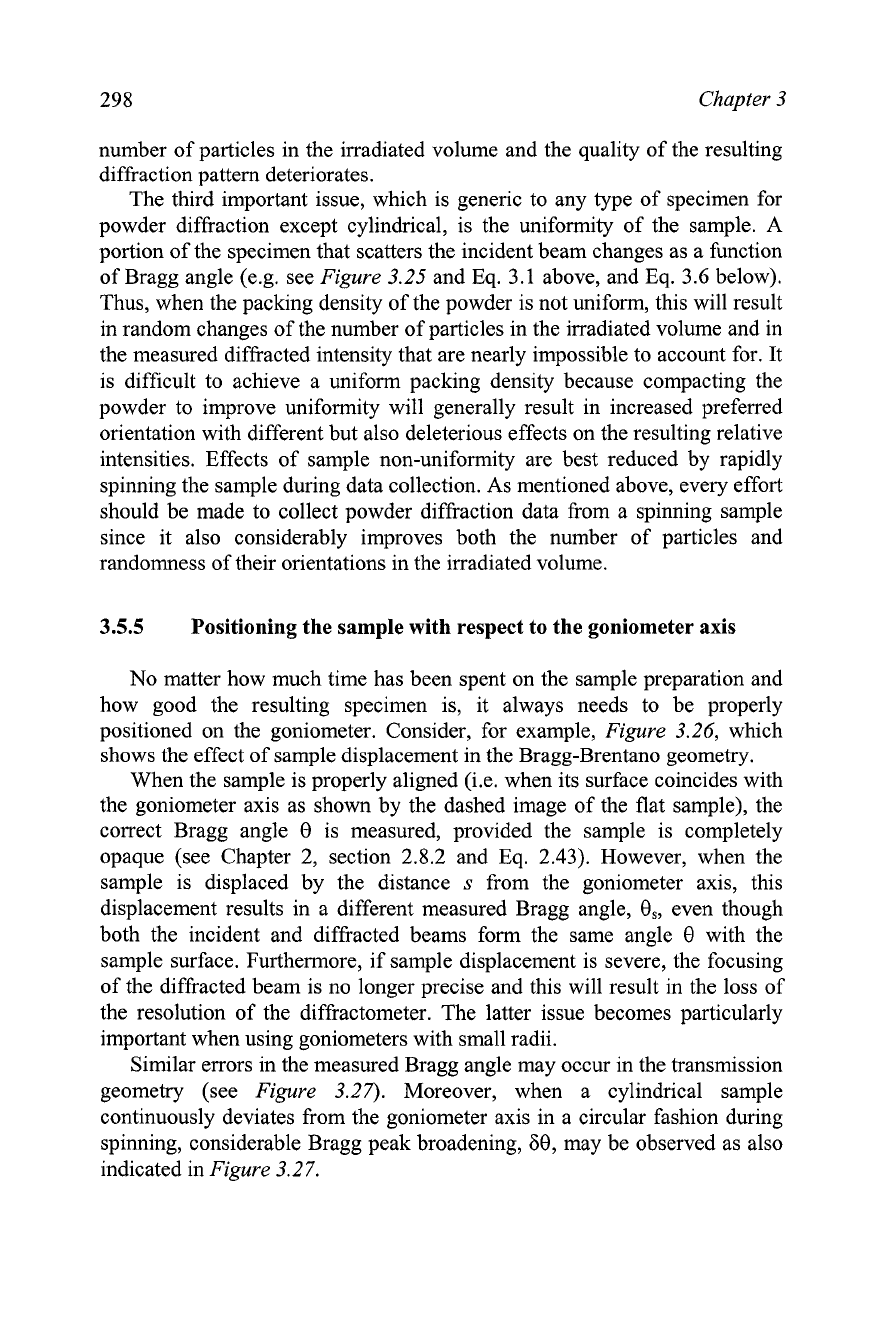
298
Chapter
3
number of particles in the irradiated volume and the quality of the resulting
diffraction pattern deteriorates.
The third important issue, which is generic to any type of specimen for
powder diffraction except cylindrical, is the uniformity of the sample. A
portion of the specimen that scatters the incident beam changes as a function
of Bragg angle
(e.g. see
Figure
3.25 and Eq. 3.1 above, and Eq. 3.6 below).
Thus, when the packing density of the powder is not uniform, this will result
in random changes of the number of particles in the irradiated volume and in
the measured diffracted intensity that are nearly impossible to account for. It
is difficult to achieve a uniform packing density because compacting the
powder to improve uniformity will generally result in increased preferred
orientation with different but also deleterious effects on the resulting relative
intensities. Effects of sample non-uniformity are best reduced by rapidly
spinning the sample during data collection. As mentioned above, every effort
should be made to collect powder diffraction data from a spinning sample
since it also considerably improves both the number of particles and
randomness of their orientations in the irradiated volume.
3.5.5
Positioning the sample with respect to the goniometer axis
No matter how much time has been spent on the sample preparation and
how good the resulting specimen is, it always needs to be properly
positioned on the goniometer. Consider, for example,
Figure
3.26, which
shows the effect of sample displacement in the Bragg-Brentano geometry.
When the sample is properly aligned
(i.e. when its surface coincides with
the goniometer axis as shown by the dashed image of the flat sample), the
correct Bragg angle 0 is measured, provided the sample is completely
opaque (see Chapter 2, section 2.8.2 and Eq. 2.43). However, when the
sample is displaced by the distance
s
from the goniometer axis, this
displacement results in a different measured Bragg angle, O,, even though
both the incident and diffracted beams form the same angle
0
with the
sample surface. Furthermore, if sample displacement is severe, the focusing
of the diffracted beam is no longer precise and this will result in the loss of
the resolution of the diffractometer. The latter issue becomes particularly
important when using goniometers with small radii.
Similar errors in the measured Bragg angle may occur in the transmission
geometry (see
Figure
3.27). Moreover, when a cylindrical sample
continuously deviates from the goniometer axis in a circular fashion during
spinning, considerable Bragg peak broadening, 60, may be observed as also
indicated in
Figure
3.2
7.
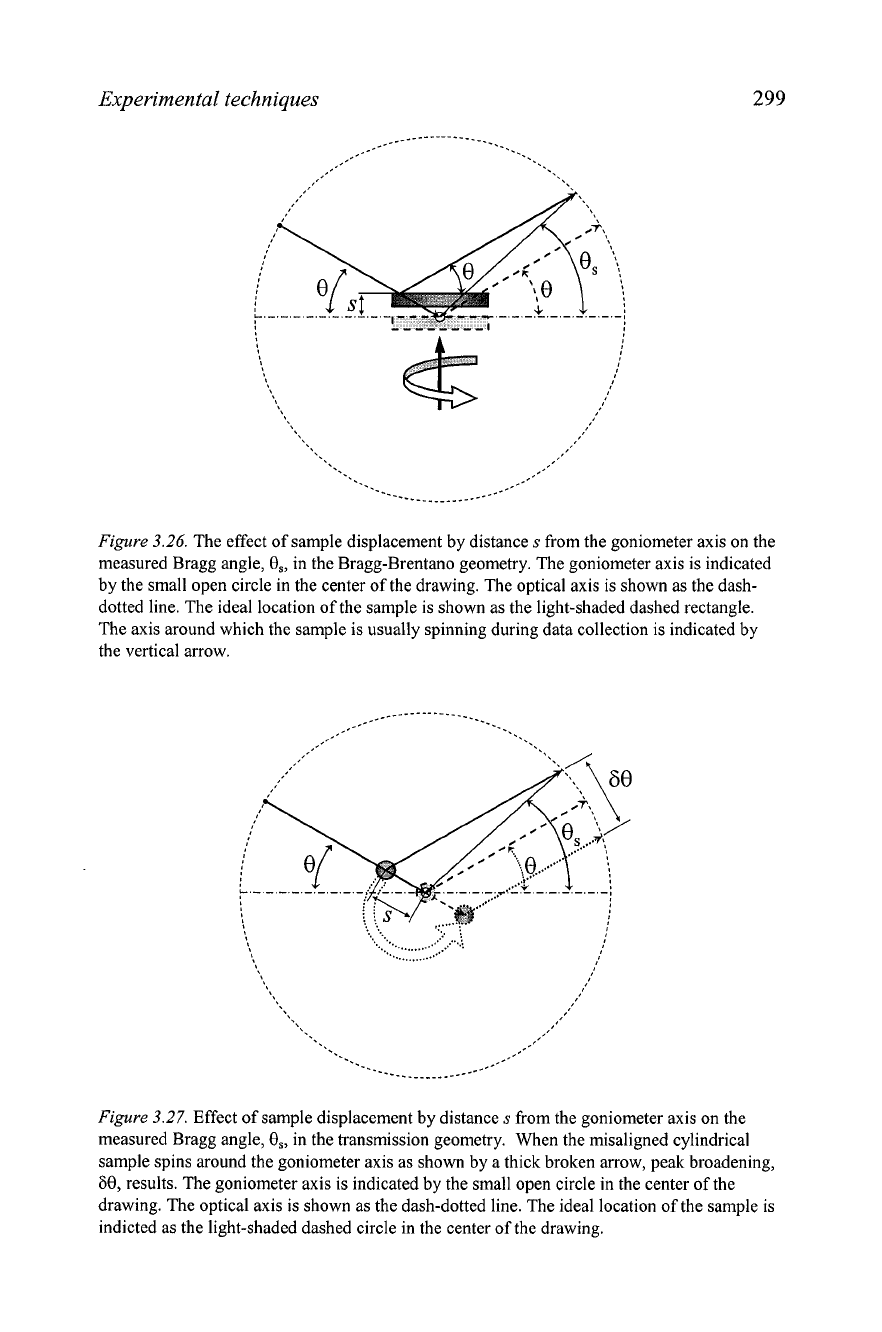
Experimental techniques
Figure
3.26.
The effect of sample displacement by distances from the goniometer axis on the
measured Bragg angle,
O,,
in the Bragg-Brentano geometry. The goniometer axis is indicated
by the small open circle in the center of the drawing. The optical axis is shown as the dash-
dotted line. The ideal location of the sample is shown as the light-shaded dashed rectangle.
The axis around which the sample is usually spinning during data collection is indicated by
the vertical arrow.
Figure
3.27.
Effect of sample displacement by distance
s
from the goniometer axis on the
measured Bragg angle,
8,,
in the transmission geometry. When the misaligned cylindrical
sample spins around the goniometer axis as shown by a thick broken arrow, peak broadening,
60,
results. The goniometer axis is indicated by the small open circle in the center of the
drawing. The optical axis is shown as the dash-dotted line. The ideal location of the sample is
indicted as the light-shaded dashed circle in the center of the drawing.
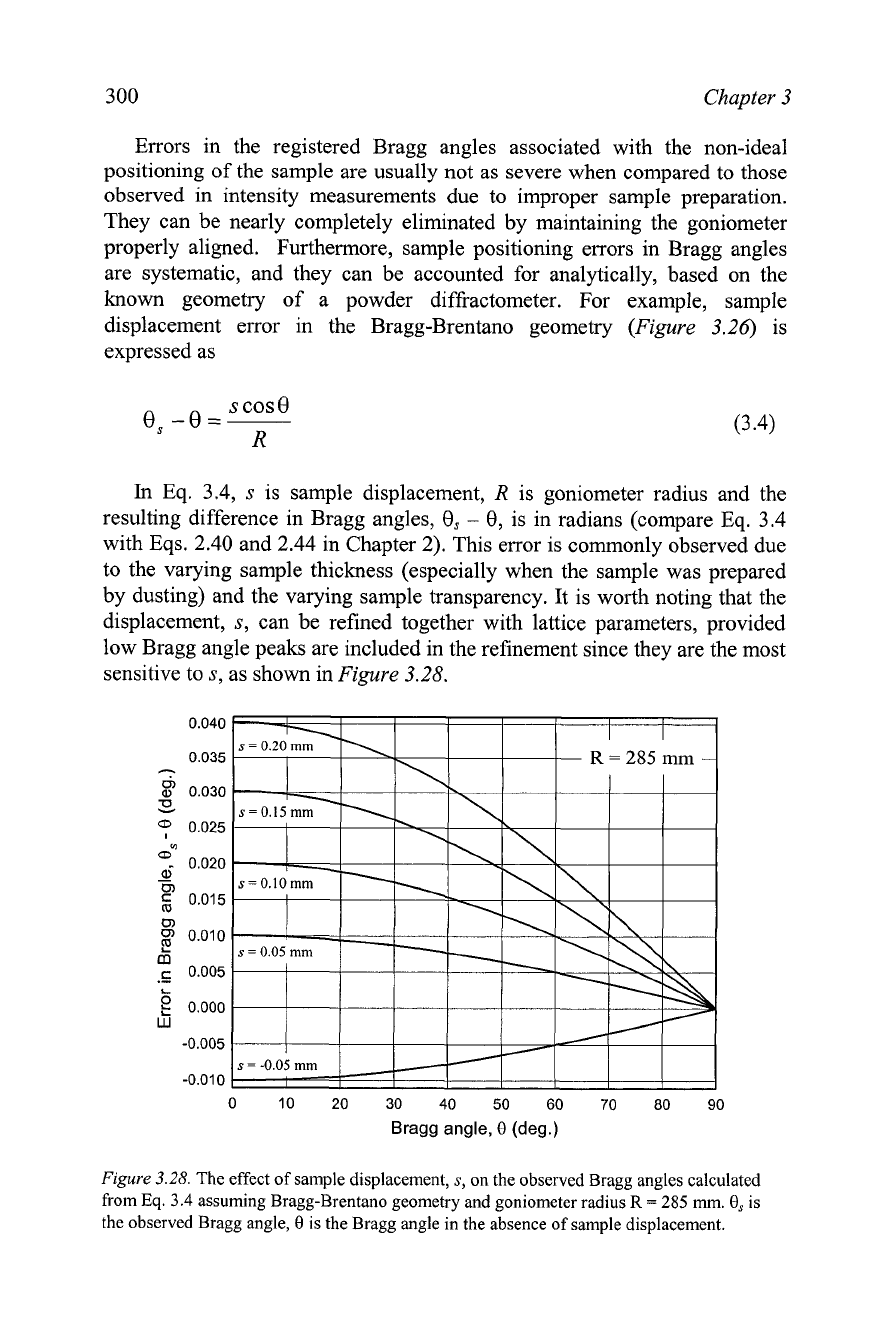
300 Chapter
3
Errors in the registered Bragg angles associated with the non-ideal
positioning of the sample are usually not as severe when compared to those
observed in intensity measurements due to improper sample preparation.
They can be nearly completely eliminated by maintaining the goniometer
properly aligned. Furthermore, sample positioning errors in Bragg angles
are systematic, and they can be accounted for analytically, based on the
known geometry of a powder
diffi-actometer. For example, sample
displacement error in the Bragg-Brentano geometry (Figure
3.26)
is
expressed as
s
cos
e
8,
-€I=-
R
In
Eq. 3.4,
s
is sample displacement,
R
is goniometer radius and the
resulting difference in Bragg angles,
8,
-
8,
is in radians (compare Eq. 3.4
with Eqs. 2.40 and 2.44 in Chapter 2). This error is commonly observed due
to the varying sample thickness (especially when the sample was prepared
by dusting) and the varying sample transparency. It is worth noting that the
displacement, s, can be refined together with lattice parameters, provided
low Bragg angle peaks are included in the refinement since they are the most
sensitive to s, as shown in Figure
3.28.
Bragg angle,
0
(deg.)
Figure
3.28.
The effect of sample displacement,
s,
on the observed Bragg angles calculated
from
Eq.
3.4
assuming Bragg-Brentano geometry and goniometer radius
R
=
285
mm.
0,
is
the observed Bragg angle,
0
is the Bragg angle in the absence of sample displacement.
